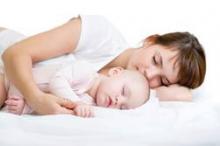Bed sharing was a risk factor for almost three-quarters of infant sleep deaths for children under age 1 year, but the contribution of this and other risk factors varied by the children’s age, according to a recent study.
Jeffrey D. Colvin, M.D., J.D., of Children’s Mercy Hospitals and Clinics in Kansas City, Mo., and his associates analyzed 8,207 sleep-related deaths of infants under age 1 year between 2004 and 2012 in 24 states, using data from the National Center for the Review and Prevention of Child Deaths (NCRPCD) Case Reporting System (Pediatrics 2014 July 14 [doi:10.1542/peds.2014-0401]).
They calculated the odds of death for sleep position, sleep location, and having any object in the sleep environment after adjusting for race/ethnicity, gender, and having a complex chronic condition such as cerebral palsy, a congenital heart defect, or a chromosomal abnormality. Objects included blankets, pillows, bumper pads, hard furniture, toys, clothing, bags, cords, positional support wedges, cloths, bibs, and other items.
The median age at time of death was 2 months, 98.8% did not have a complex chronic condition, and just over a third of the total deaths (38.2%) were classified as unknown.
Although 69.2% of the infants were bed sharing, this factor was much more likely to be associated with the deaths of younger infants (73.8% for those under age 4 months) than older infants (58.9% for those aged 4 months to 1 year, P less than .001). Younger infants also were more likely to be sleeping on an adult bed and/or a person (51.6%), compared with older infants (43.8%, P less than .001), Dr. Colvin and his associates reported.
Yet a greater proportion of older infants (39.4%) than younger infants (33.5%) had at least one object in the sleeping environment, most commonly blankets (24.5%) or pillows (17.6%) for all the infants. Blankets, stuffed toys, bags, hard furniture, and cords were each implicated in a slightly higher percentage of older than younger infants’ deaths, the investigators said.
More younger infants (37.3%) than older infants (28.7%) were placed on their side or stomach (P less than .001), but only 13.8% of younger infants moved from their sides or backs to their stomachs during sleep, compared with 18.4% of older infants. Although 39.7% were placed on their backs, as recommended, the most common position the babies were found in was on their stomach (38.3%), particularly for older infants (42.2%), compared with younger infants (36.6%).
"The predominant risk factor for younger infants is bed sharing, whereas rolling to prone, with objects in the sleep area, is the predominant risk factor for older infants," Dr. Colvin and his associates wrote. "Parents should be reminded that cribs should be clear of any objects, so that if the infant rolls, there is no risk of rolling into something that may create an asphyxial environment."
The research was supported by the CJ Foundation for SIDS, the National Institutes of Health, and the maternal and child health branch of the Health Resources and Services Administration. The authors reported no disclosures.


